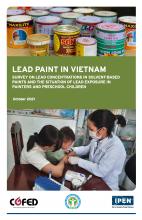
Global mercury pollution has been recognised as a major problem that can only be tackled effectively by international regulation and government cooperation. Mercury is a hazardous neurotoxin that can cause many health problems in humans, and most exposure is caused by dietary impacts such as eating contaminated fish where mercury bioaccumulates. The Minamata Convention on Mercury has been developed as the main international legal instrument to protect human health and the environment from mercury pollution with range of controls on trade, emissions, and use of mercury.
The second segment of COP 4 will be held as a face to face meeting from March 21-25 in Bali, Indonesia. Ahead of that meeting, further IPEN policy positions to address agenda items will be posted here. The Bali meeting will see several controversial issues negotiated including determination of waste thresholds to define mercury waste, proposed amendments for rapid phase out of dental amalgam, additions to product annexes and outcomes of the long reports from parties (due for submission December 2021). Reporting is a key issue as it should make transparent which parties are mining, trading, stockpiling, and using mercury, including how they use mercury and manage mercury waste. The first reports had high rates of submission, but the data quality was so poor that the secretariat could not inform the COP of key issues (see IPEN intervention on ‘reporting’). It is hoped that the quality of information provision will improve in the long format reporting due by the end of 2021.
Click here for IPEN's Quick view of this meeting - click here for What Happened at Mercury Treaty COP 4.2
What happened at the Mercury Treaty COP 4.1?
The online meeting for COP 4.1 of the Mercury Treaty was held on the 1st -5th November 2021. The meeting was largely administrative in the sense that only the ‘essential’ agenda items were considered although the full agenda was adopted. The items were considered necessary to allow the Convention to continue functioning or had time-sensitive elements that required attention.
COP 4.1 online prioritised the issues of Budget and Programme of work. Most of the week was dedicated to the contact group on Budget and Programme of work with observers excluded from both the contact group and regional meetings.
The plenary sessions held on the Monday and Wednesday was our only real opportunity to engage with the meeting and interventions were highly limited due to time constraints and technical difficulties. However, we were able to deliver an intervention on reporting (Article 21) on Wednesday. The final plenary session of Friday the 5th November was held mainly in decision making mode again making it virtually impossible to intervene.
Click here for IPEN's Quick view of this meeting
The outcome of the meeting was that the budget was passed, priorities for action on mercury were recommended to the Global Environment Facility (financial mechanism), guidance on reporting was presented, and a proposal for moving forward on effectiveness evaluation of the convention was considered.
The four main topics for the meeting were:
Effectiveness Evaluation
Ongoing debates around several administrative and substantive issues have bogged down progress on effectiveness evaluation since COP 3. The type of indicators required and the structure of the Effectiveness Evaluation (EE) committee and analysis team among them. Norway and Canada have proposed a roadmap forward in Conference Room Paper 1 (CRP1) which was presented early at COP 4.1. Intersessional work on this issue through a party led initiative had assisted to reduce the areas of contention but it is hoped that CRP1 will provide the basis to resolve all remaining issues at COP 4.2. This item has an element of time sensitivity as the COP requires and effectiveness evaluation to be underway by 2023 and if a resolution is not found by the end of the COP 4.2 meeting in Bali in March 2022, then that time frame may be at risk. Norway requested that the secretariat invite written comments and to arrange an online session for parties to exchange views on the framework in CRP1 ahead of COP 4.2.
Programme of work and budget
This was one of the time sensitive agenda items as the budget adopted by COP-3 will expire at the end of 2021 and to ensure continuous funding of the convention the COP 4.1 meeting needed to approve a budget to allow work to continue at COP 4.2 where the 2022 -2023 can be reconsidered in full. The secretariat presented a case that costs had risen for administration of the convention with rising secretariat staffing costs, scientific work to support the convention and funding necessary to support the initiation of the effectiveness evaluation process. A zero-growth budget scenario and an optional 5% nominal increase budget scenario were included in the budget meeting documents with the secretariat indicating that a 5% increase best met the needs of the convention. Sam Adu-Kumi (Ghana) and Reginald Hernaus (Netherlands) co-chaired the contact group on this item which had 200 delegates attend (observers were excluded) and an area of significant debate was the costs around effectiveness evaluation. A decision was taken to approve the budget for the general trust fund for 2022 of USD 3,397,684 million as part of the budget for the biennium 2022−2023. The budget discussions will recommence at COP 4.2. The Executive Secretary was also permitted to draw down on the surplus from the general trust fund the amount of up to USD 500,962 to cover some costs of COP 4.
National reporting
Parties were required to submit short format reports by December 31, 2019 and long format reports by December 31, 2021. While reporting rates for the short format reports were high (89%) the data content of the reports was relatively poor. So much so that the secretariat has not been able to use the information to reliably inform the COP of key issues such as how much mercury has been mined, by whom, where it was traded and for what use. There was also concern that the information did not allow the secretariat to determine which parties had ESM or dedicated treatment facilities for mercury waste. This is critical data that the COP must be informed of to accurately assess the effectiveness of the convention and where to direct resources.
In recognition of the need to improve reporting the secretariat issued further guidance on how to report accurately on the matters required under Article 21 and other matters further determined by the COP. The guidance will not be formally adopted until COP 4.2 but parties were encouraged to trial it to improve reporting quality.
Dates of the Resumed Fourth Meeting of the COP
There were several comments by parties in plenary, when discussing the next segment of COP 4, that the emergency online meeting measures employed during the pandemic should not establish any form of precedent (in operational terms) when face to face meetings resumed. Several parties and regions were concerned that the online format did not allow for full deliberation of issues and was not a suitable format for negotiations on keys decisions.
In particular, countries from the south have been disadvantaged by poor connectivity to online meetings, challenging working hours due to time zone differences and other barriers to participation. IPEN agrees that online engagement has been very problematic for many parties and observers alike and that the face to face meetings should not continue with the restrictions imposed by online meetings.
This will have ongoing significance for COP 4.2 as the host country Indonesia has proposed to have much smaller delegations (for social distancing) limited to 4 delegates per party and an unspecified but limited number of observers. Observers have endured increasingly restricted opportunities to engage with delegates with both regional meetings and contact groups on budget excluding observers at this COP and the previous BRS COP online. This practice should not be permitted to continue once face to face meetings resume. A decision was taken in plenary to proceed with the face to face second segment of the COP 4 in Bali Indonesia, March 21-25, 2022.
Financial mechanism
The financial mechanism of the convention was raised as an agenda item specifically so that there was an ability by parties to give targeted interventions in plenary. These may be forwarded to the meetings considering the GEF 8th replenishment to assist with determining mercury funding priorities. The financial mechanism is much broader than this item and includes issues such as the Specific International Programme for funding capacity building and technology transfer projects. However, given the time constraints of the online meeting the discussion was limited to interventions in plenary by parties seeking to suggest priorities to be considered within the planning stage of the GEF 8th replenishment. No decisions were made on this item.
The Bali Declaration on Combatting Global Illegal Trade of Mercury
There was also a presentation of what Indonesia called a 'political document' which is a draft declaration seeking party cooperation to crack down on illegal mercury trade which is a major problem for parties with ASGM. While the Bali declaration is largely symbolic it does draw attention to the need to act on the illegal mercury trade and it grows and continues to feed the ASGM trade. There will be several consultation sessions on the declaration before COP 4.2. The next consultation round will be 6 November 2021 – 31 January 2022 followed by text consolidation and a further round of consultation on 16 February – 16 March 2022. Final consolidated text will be distributed on 21 March 2022 followed by a Special Brief Session of the Final Consolidated Text: 25 March 2022.








